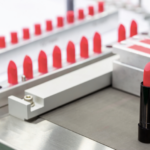Originally published February 26, 2021
The International Organization for Standardization (ISO) 22716 is a set of comprehensive guidelines on Good Manufacturing Practice (GMP) for cosmetics. It covers the production, control, storage, and shipment of products.
Cosmetics refer to any personal care products intended to enhance, cleanse, or alter a consumer's face or body. This includes makeup, oral care, and products such as creams, deodorants, hair products, and fragrances.
The ISO is an internationally recognized non-governmental body that sets many standards across a wide range of industries.
In 2007, the International Cooperation on Cosmetic Regulations (ICCR), formed by the United States (US), Canada, European Union (EU), and Japan, determined this standard would be used when recommending or publishing cosmetic GMP guidelines for each country[1]. This makes ISO 22716 the basis of cosmetics GMP as it applies to international standards.
In 2013, the Food and Drug Administration (FDA) in the US published its updated GMP guidelines, considering the recommendations stated in ISO 22716.
Cosmetics GMP, or cGMP, emphasizes requirements for companies to adopt tools and technologies consistent with current ISO standards[2].
Good Manufacturing Practice Cosmetics Standard
This ISO standard is the benchmark in cosmetics GMP. ISO 22716 certification helps businesses identify and mitigate the risks associated with production that can impact product safety and quality. As its name implies, GMP allows organizations to demonstrate their commitment to safeguarding the quality and safety of their finished cosmetics products.
GMP is the first step in cosmetics compliance, providing a comprehensive approach for quality management. It assures that the way a product is designed, formulated, manufactured, packaged, stored, and shipped is achieved safely, hygienically, and responsibly.
The success of all cosmetics businesses relies heavily on its capacity to produce effective, safe, high quality, and reputable cosmetic products. Understanding the fundamentals of GMP is extremely beneficial, addressing one of the most important aspects of cosmetics manufacturing: To protect consumers by enhancing cosmetic product safety across all elements of the supply chain.
Global GMP Regulations
The Cosmetics Regulation 1223/2009 requires that all cosmetic products manufactured and sold into the EU market comply with cGMPs based on the ISO 22716 standard.
Following GMP guidelines can extend beyond legal compliance. It benefits companies through increased sales and brand loyalty by placing an emphasis on products' quality, safety, and efficacy.
Compliance with good manufacturing practices for cosmetics is mandatory in the EU. However, in the US and Canada, there are various regulations that govern the sale of cosmetic products.
Implementing GMP standards has not historically mandatory but highly encouraged by the FDA and Health Canada[3]. As of 2024, however, that is subject to change.
Current and upcoming cosmetics safety guidelines in the U.S. and Canada include:
- Federal Food, Drug and Cosmetic Act (Section 301). This FDA-enforced rule forbids the sale of cosmetic products that are "adulterated" or "mis-branded"
- Modernization of Cosmetics Regulation Act of 2022 (MoCRA). U.S. legislation that requires cosmetics marketed in the U.S. to be manufactured in accordance with GMPs which will be determined and enforced by FDA
- Food and Drugs Act (Sections 16 and 18). States that cosmetics sold in Canada must be produced and stored in clean, hygienic environments
GMP Guidelines for Cosmetics
Implementing industry standard GMPs according to ISO 22716:2007 requires considering the following GMP guidelines[4]:
- Personnel and premises
- Equipment, raw, and packaging materials
- Production
- Finished products and quality control
- Complaints and recalls
Personnel
GMP guidelines for cosmetics personnel center around assuring that they contribute to safety and quality rather than compromising it. Cosmetics company employees should be adequately trained, experienced, and qualified to correctly produce, store, and control products to correct specifications.
They should also have the necessary support to perform their tasks efficiently with good hygiene and cleanliness. This support may include:
- Full GMP training (personnel hygiene and health)
- Supervision
- Safety equipment
- Personal protective equipment (PPE)
- Education
- Resources
Premises
A cosmetics manufacturer's premises should always meet the GMP specifications; providing a safe, hygienic environment that minimizes contamination risk.
Amenities should put cleaning and maintenance protocols in place and allow for an adequate division of:
- Storage
- Production
- Quality control
- Washing and sanitization
- Toilet facilities
- Any further supporting facilities
This protects any manufactured products, minimizes the risk of mixing up products, ingredients, and packaging materials, and keeps cleanliness to a high standard as part of the GMP process.
Equipment
All equipment used must be suitable for its purpose and adequately cleaned, sanitized, and maintained to prevent air contamination such as dust or moisture.
A core part of a company’s GMP procedure is not to use cosmetics manufacturing equipment for any other purpose. It should also be stored properly and calibrated periodically if needed.
Equipment shouldn't be made of any material that could interact with the ingredients, products, or cleaning agents. If broken or no longer suitable for use, GMP guidelines require companies to fix, replace, or dispose of equipment adequately and safely.
Raw and Packaging Materials
All ingredients, raw materials, and packaging materials should meet an acceptance criterion for quality assurance purposes.
All raw materials should be well organized and correctly labeled along with packaging materials to prevent mix-up with any products. These labels must contain batch/lot information so that they can be traced at any point in the manufacturing process.
GMP guidelines also require companies to carry out regular stock inventories and investigate any discrepancies.
Production
Measures should be taken at every step to make sure that the finished product meets its specifications. Appropriate documentation and records should be created to capture all aspects of the production process.
The guideline recommends establishing standard operating procedures (SOPs) for all processes. An SOP is simply a clearly written instructional document that clarifies in detail how a specific production activity is conducted.
This includes GMP for cosmetics guidelines, the new product formulation of the cosmetic product in percentages, and weight/volume. Also, a list of all the raw materials used including their batch number, quantities, manufacture method.
Finished Products
Finished products must meet the quality standards established by the company and reflect good manufacturing practices. Before a finished product reaches the market, companies need to verify compliance with defined quality criteria.
Finished products should also meet strict storage regulations on appropriate conditions. Finished product storage containers should list the product's:
- Name
- Batch number
- Relevant storage conditions
- Quantity
Regular inventory checks confirm that products are being stored adequately. This will help them maintain the quality required during storage operations, shipping, and product returns.
Quality Control
“Quality” refers to the stability of a cosmetic product, its preservation, and its overall function. Many of the required tests check that the quality of a product remains at a high standard.
Any products containing water are at risk of microbial growth contamination. They will require sampled quality checks to ensure they remain stable and pass challenge tests.
For sampling and testing purposes, samples must be identifiable by their:
- Name
- Concentration
- Expiration date
- Opening date
- Storage conditions
- Name of the person who prepared them
Companies should take sufficient sample sizes so that any local regulatory body can analyze them if necessary.
Complaints and Recalls
Any complaints or adverse events reported about a cosmetic product must be reviewed, investigated, and followed-up on.
All complaints should be centrally recorded using a systematic complaint logging and review process. Complaint investigations should include steps that prevent a product defect from reoccurring and measures to better recognize potential issues with safety or quality.
If a severe or high-risk safety or quality issue is suspected, a company must be capable of implementing a product recall quickly and efficiently.
Again, relevant documentation should show a systematic plan of action to inform the appropriate authorities of the recall, which could impact consumer safety.
Internal Audits and Documentation
Internal audits are essential for assuring cosmetics GMP implementation and enforcement and evaluating a company's overall performance. The audit should identify your quality management system's strengths and weaknesses and offer a plan of action to overcome GMP failings.
A good internal audit requires objectivity and should be performed by a qualified person. Any problems found during audits must be corrected, verifying that all guidelines outlined in the ISO 22716 standard are correctly implemented[5].
Simplify GMP Compliance for Your Cosmetics Company
At Registrar Corp, we’ve assisted thousands of cosmetics companies across 180 countries maintain GMP compliance through our product platform, Cosmetri GMP.
This innovative software solution allows users to:
- Comply with ISO 22716 requirements
- Conduct internal audits
- Digitally manage and store GMP documents
- Trigger product recalls
- And more
See how Cosmetri GMP can support your cosmetics business by requesting a demo today.
Looking for cosmetics GMP training for your team? Registrar Corp also offers ISO 22716 certification and other GMP courses through our Online Training platform.
Footnotes:
[1] ISO 22716:2007 - Cosmetics — Good Manufacturing Practices (GMP) — Guidelines on Good Manufacturing Practices
[2] Draft Guidance for Industry: Cosmetic Good Manufacturing Practices
[3] How FDA Approves Drugs and Regulates Their Safety and Effectiveness
[4] ISO 22716 – Cosmetic GMP - Certifications
[5] Guidelines for Good Manufacturing Practice of Cosmetic Products (GMPC), Council of Europe, Council of Europe, 1 Jan 1995






